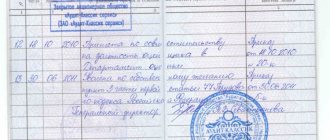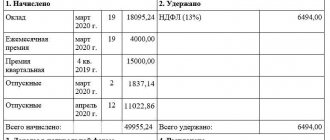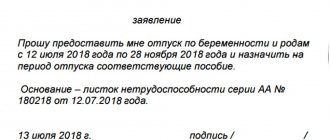The law obliges employers to make all payments due to them on the last working day of a dismissed employee: wages, bonuses, overtime allowances, compensation and others. In the article we will tell you how to calculate compensation upon dismissal if there is no average earnings, and we will give a formula for calculating it.
In order to calculate compensation for vacation that the employee did not have time to take before dismissal, you will need to know the average daily earnings (later in the article the abbreviation will be used - SDZ). An accountant must be able to calculate it correctly, since the calculation is influenced by many factors. In any case, the SDZ depends only on the employee’s income during work and the period of time worked. Therefore, if there is no average earnings to calculate compensation, it certainly needs to be calculated.
How to calculate average daily earnings upon dismissal
Calculation methods are presented in the table:
| SDZ is taken into account | Don't count |
| Any income in the company from which personal income tax and contributions to extra-budgetary funds were paid | “Black” salary |
| Bonuses, allowances | Payments that are one-time in nature |
| Year-end bonus, long-service payments, 13th salary | Payments not related to wages (compensations, social support, etc.) |
| Vacation pay |
SDZ is calculated using the following formula:
SDZ = SOD : CHVR,
- where SOD is the amount of total income (usually for the year),
- NVR – number of exits to the workplace during the same time.
NVR = KM x 29.3,
- where KM is the number of months taken into account (rounded up to the full - up if the staff worked more than half the month, and down if less than half),
- 29.3 – average number of working days in a month (fixed value) – from this number, as many days as the employee did not work due to illness or being on unpaid leave are subtracted.
The calculated SDZ cannot be less than the minimum wage (from July 2017 - 7800 rubles).
The following are excluded from the SDZ calculation:
- The time during which the employee did not work, but at the same time retained his salary in accordance with the provisions of the Labor Code of the Russian Federation (except for the time for feeding the baby).
- The period of receiving benefits for illness or maternity leave.
Compensation upon dismissal for less than a month 2021
Question: What is the compensation for unused vacation upon dismissal if the employee worked in the organization for less than a month? Melikhov I.R., HR department specialist, Lyubertsy, Moscow region.
Answer: Upon dismissal, the employee is paid monetary compensation for all unused vacations1.
Obviously, the amount of compensation depends on the number of vacation days unused by the employee at the time of dismissal and the length of service with a given employer, determined in accordance with Article 121 of the Labor Code of the Russian Federation.
The number of calendar days of unused vacation is determined by calculation and depends on the duration of the next vacation. If it is 28 calendar days, then the calculation is based on 2.33 days of vacation per month of work (28/12). If the holiday is extended, the unit of account will change.
Compensation for leave upon dismissal: frequently asked questions
That is, even if an employee was sick for a month out of two workers, he is still due compensation for unused vacation upon dismissal. This statement is true for all categories of employees, even temporary or seasonal ones. Example of calculating compensation So, let's assume that the employee worked at the company for only 3 whole months.
Compensation upon dismissal for less than a month
- Firstly, in a general way, his salary is divided by the number of days in the month, but then multiplied by the number of days during which the employee was present at the workplace;
- Secondly, the average monthly earnings for the last 12 months are calculated (the total salary payable is divided by 12), which is divided by the number of days in the month and multiplied by the number of days the employee is absent.
The obtained values are summed up and the salary of the dismissed employee for less than a month is entered. What days of absence of an employee in his place require his salary to be retained? These are annual vacations, business trips, periods of temporary disability certified by sick leave and those strikes in which the employee does not participate. 2. The dismissal took place during a month with holidays.
Compensation upon dismissal for 10 days of work
Okean LLC as an accountant since March 1, 2007. On March 16, he resigned of his own free will. The regular vacation at Okean LLC is granted to all employees for a duration of 28 calendar days per working year. Krylov I.G. worked at Okean LLC for 16 days, that is, more than half a month.
Therefore, he is entitled to compensation for unused vacation for one full month. For each month of work, an employee is entitled to 2.33 calendar days of vacation. Consequently, Krylov I.G.
compensation is also due for 2.33 days (or 3 days when rounded in favor of the employee).
Average daily earnings are calculated for the last 12 calendar months by dividing the amount of accrued wages in the billing period by 12 and by 29.4 (the average monthly number of calendar days).
Compensation upon dismissal if a person worked for less than a month
The second is appropriate for those organizations within which employees carry out activities over weeks and months. The method of calculating wages for an incomplete month is necessarily fixed in the internal documents of the organization, including the collective agreement and labor regulations.
Above is the most common example of calculating wages for an incomplete month. In practice, HR workers are faced with a large number of nuances. 1. The employee was absent from work for several days, but his salary was retained.
Under this condition, the calculation of wages for an incomplete month will be slightly different.
At the same time, the current Russian labor legislation does not establish the minimum length of service that is necessary for an employee to have the right to the specified leave.
To solve this problem, Rostrud proposes to use the Rules on regular and additional leaves, approved. NKT of the USSR on April 30, 1930 (hereinafter referred to as the Rules), which can be applied on the basis of Article 423 of the Labor Code of the Russian Federation9.
Paragraph 35 of the Rules provides: “When calculating the terms of work giving the right ... to compensation for leave upon dismissal, surpluses amounting to less than half a month are excluded from the calculation, and surpluses amounting to at least half a month are rounded up to a full month.”
From the above rule, the following conclusion is usually drawn: “Thus, only employees who have worked in the organization for at least half a month have the right to compensation upon dismissal”10.
Compensation upon dismissal if the employee worked for less than a month
Moreover, such restrictions are permissible only to the extent necessary in order to protect the foundations of the constitutional system, morality, health, rights and legitimate interests of other persons, ensuring the defense of the country and the security of the state.
Consequently, the application of the Rules contradicts the Basic Law of the country and is not consistent with the Labor Code of the Russian Federation.
And from Part 1 of Article 423 of the Labor Code of the Russian Federation, it follows that legislative and other regulatory legal acts of the former USSR in force on the territory of the Russian Federation can be applied only to the extent that they do not contradict the Labor Code of the Russian Federation.
It seems that the use of rounding in this case is unacceptable and each day worked by the employee must be taken into account when calculating compensation for unused vacation. In other words, the billing period must be made not a calendar month, but a calendar day.
Vacation compensation if a person worked for less than a month
The formula for calculating compensation in this case will take the following form: OB = 28/12*6 * Average daily earnings of the employee. There are several exceptions to the general rules. Calculation for the dismissal of an employee who has worked for less than a month. This process consists of several stages:
- An employee’s vacation period is calculated in full months – that is, only those months in which the employee worked for more than 15 days are taken into account;
- The number of days allotted to a person for the entire period of his work in the company is determined (28 days for every 12 months);
- Days that have already been used as vacation are deducted.
All calculations are carried out in relation to the annual period worked by the employee in the organization (Resolution of the Government of the Russian Federation No. 922).
- Calculation upon dismissal of an employee who has worked for less than a month
- Compensation for leave upon dismissal
- If the employee worked for less than 2 months, calculation of compensation upon dismissal
Compensation for leave upon dismissal: frequently asked questions Compensation for dismissal for less than a month In labor legislation, there are two important concepts:
- Full compensation is calculated in the standard manner above, provided that the employee has worked for the company for one year or more;
- Incomplete compensation affects those employees whose employment lasted more than 6 months but less than a year.
In the second case, when calculating unused leave upon dismissal, a conditional rounded period of 6 months is used, even if the employee’s actual activity lasted longer.
Compensation for unused vacation for less than a month
Above is the most common example of calculating wages for an incomplete month. In practice, HR workers are faced with a large number of nuances. Compensation for leave upon dismissal How to correctly carry out this procedure? Currently, two different methods are used in practice:
- Based on the actual number of days in a month. When choosing this option, you must divide the employee’s salary (average monthly earnings or salary) by the actual number of days in the month, and then multiply by the number of days worked by the employee:
Salary = Monthly salary / Number of days in a month * Number of days worked
- By the nominal number of days in a month. Regulatory documents establish the average value of days in a month, which in Russia amounted to 29.4 days in 2021.
Compensation for unused vacation upon dismissal, worked for less than a full month
Even in those months on which public holidays, noted in labor legislation (Article 112 of the Labor Code of the Russian Federation), fall, the employee’s salary is paid in full. That is why, even when calculating payments for an incomplete month, holidays are considered as working days. In other matters, calculations are made according to the standard scheme described in such articles of the Labor Code of the Russian Federation as:
133 – determination of the minimum acceptable salary;
- Art. 136 – terms and process of calculating wages;
- Art. 137 – restrictions on delays in payment of wages;
- Art.
139 – establishing the average salary; - Art. 142 – responsibility for issuing wages to employees of the organization;
- Art.
152-154 – features of calculating wages for overtime work, activities on holidays and at night; - Art.
Compensation for unused vacation worked for less than a month
Source: https://map-expo.ru/uvolnenie/kompensacija-pri-uvolnenii-za-nepolnyj-mesjac.html
How to determine average daily earnings if there were no accruals
It happens that an employee did not have any payments for a period. Then the SDZ is calculated as follows:
- If the employee did not work at all, or the entire period consisted of excluded days, then the value of the SDZ is calculated using information on wages for the previous year.
- If the employee did not carry out work either in the current or in previous periods, the SDZ is calculated based on the actual appearances at work during the month when it became necessary to find out the SDZ.
- If an employee has not worked a single day, the tariff rate approved for his position is taken.
Preferential vacation
Workers employed in the northern regions of the country have the right to additional leave in accordance with Art.
321 Labor Code of the Russian Federation. Part-time workers cannot count on this privilege (Part 2 of Article 321 of the Labor Code of the Russian Federation). The article does not establish restrictions in relation to temporary workers hired under an employment contract for a period of up to 2 months or for seasonal work for up to 6 months. They are likely entitled to additional paid time off. The opportunity for northerners to receive additional paid rest time comes after 6 months from the date of hiring (Part 1 of Article 322 of the Labor Code of the Russian Federation). If you follow this rule literally, then you are entitled to only 2 days of vacation per month worked.
For example, an organization located in the Far North hired an employee under an employment contract for a period of 2 months (from 06/13/2018 to 08/12/2018). After working for less than a month, he quit on June 27, 2018. He received a salary of 5364.00 rubles.
In this example, compensation for unused vacation for an incomplete month will be calculated in 2 days, since 15 days are counted as a month. The average daily salary will be 366.14 rubles. = 5364 / (29.3 / 30 * 15). The employee will receive compensation in the amount of 732.28 rubles. (366.14 * 2).
There is another point of view: such employees have the right to additional rest time on the same basis as permanent employees. Labor law does not clearly regulate this issue. Followers of this point of view consider it discriminatory to not provide additional leave to temporary workers. By stipulating the conditions for receiving compensation in the employment contract, you can solve this problem: provide 2 days on the basis of Art. 291, 295 of the Labor Code of the Russian Federation, separately calculate the payment for additional days in proportion to the time worked.
You are not required to pay compensation for unused vacation if you worked less than a month, taking into account rounding. If in the example we change the dismissal date to 06/26/2018, then the period worked would be 14 days. Under these conditions, work time is not counted towards vacation time; the employee has not earned a single day of paid rest.
In case of dismissal, compensation payment for vacation is subject to personal income tax and insurance contributions to extra-budgetary funds are calculated on it in the usual manner. Personal income tax must be calculated on the settlement day and transferred to the budget no later than the next working day after payment of compensation. Insurance premiums are transferred within the time limits established by the legislator for insurance premiums calculated for wages.
Calculation of average daily earnings if the billing period is not fully worked out: formula
In order to calculate SDZ when a period is not fully worked out, first find out the number of days in a given period:
KKD = 29.3: CKDM x CKDR , where
- CHKDM – number of days (calendar) in the month under consideration;
- NHKDR – the number of days (calendar) spent by an employee at work.
Formula for calculating SDZ:
SDZ = DRP: (29.3 x NCFM + NCDM) , where
- DRP – employee’s income for the billing period;
- NHOKM – the number of fully worked calendar months in the period;
- CHKDM – the number of calendar days in all months worked together in the period.
If several months were not fully worked out, the number of days in each of them is calculated separately, then the results are added up.
Calculation of average daily earnings for payment of compensation for unused vacation
To calculate the SDZ, you need to select a billing period (usually a year), find the total income, add bonuses, surcharges, etc. to its amount. The calculation scheme is as follows:
- The number of months worked is determined. If the employee did not work for a whole number of months, the indicator is taken without changes. If there were incomplete months, they are taken into account when working 15 days or more in each month and are discarded when working less than 15 days.
- The required number of vacation days is calculated.
- The days during which the employee managed to rest are subtracted from the number of days of rest.
- The result is multiplied by the SDZ.
Legislative acts on the topic
It is recommended to study in advance:
| Document | Name |
| Decree of the Government of the Russian Federation of December 24, 2007 N 922 | Calculation of SDZ for all cases, including dismissal |
| Art. 127 Labor Code of the Russian Federation | On payment of monetary compensation for unused vacation |
| Art. 181, art. 279 of the Labor Code of the Russian Federation, Resolution of the Constitutional Court of the Russian Federation dated March 15, 2005 No. 3-P | Grounds for calculating compensation to a dismissed director of an enterprise |
Calculation of compensation upon dismissal if the employee has not worked for a full year
The dismissal of an employee requires the obligatory handing over of a work book to him, as well as the provision of a full payment for the time worked (Article 140 of the Labor Code of the Russian Federation). What benefits can a dismissed employee be entitled to?
The latter is not paid in all cases, but only when the termination of the employment contract occurs at the initiative of the employer, during the liquidation of the company or in the event of staff reduction.
If less than a month has been worked, compensation upon dismissal will still be paid to the employee. The only difference is that the procedure for calculating it in this case will be slightly different.
All of these payments are calculated in the accounting department on the basis of the dismissal order.
- The number of days allotted to a person for the entire period of his work in the company is determined (28 days for every 12 months);
- Days that have already been used as vacation are deducted.
- All calculations are carried out in relation to the annual period worked by the employee in the organization (Resolution of the Government of the Russian Federation No. 922). There are two important concepts in labor legislation:
- Full compensation is calculated in the standard manner above, provided that the employee has worked for the company for one year or more;
- Incomplete compensation affects those employees whose employment lasted more than 6 months but less than a year.
In the second case, when calculating unused leave upon dismissal, a conditional rounded period of 6 months is used, even if the employee’s actual activity lasted longer.
The average daily earnings for payment of vacations granted in calendar days and payment of compensation for unused vacations are calculated by dividing the amount of wages actually accrued for the billing period by 12 and by the average monthly number of calendar days (29.4) (clause
10 Decree of the Government of the Russian Federation dated December 24.
2007 ?922) The number of calendar days in an incomplete calendar month is calculated by dividing the average monthly number of calendar days (29.4) by the number of calendar days of this month and multiplying by the number of calendar days falling on the time worked in this month.
Based on the conditions of the example, Average daily earnings = 515.99 rubles. [15,000: (29.4 x 17.07)] Number of calendar days in an incomplete month = 17.07 days. (29.4: 31 days x 18 days) Thus. the amount of compensation for unused vacation will be 1202.25 rubles (2.33 x 515.99 rubles).
Compensation upon dismissal if the employee worked for less than a month is divided
The formula for calculating compensation in this case will take the following form: OB = 28/12*6 * Average daily earnings of the employee. There are several exceptions to the general rules. Calculation for the dismissal of an employee who has worked for less than a month. This process consists of several stages:
- An employee’s vacation period is calculated in full months – that is, only those months in which the employee worked for more than 15 days are taken into account;
- The number of days allotted to a person for the entire period of his work in the company is determined (28 days for every 12 months);
- Days that have already been used as vacation are deducted.
All calculations are carried out in relation to the annual period worked by the employee in the organization (Resolution of the Government of the Russian Federation No. 922).
How to calculate vacation pay upon dismissal
Attention
At the same time, the current Russian labor legislation does not establish the minimum length of service that is necessary for an employee to have the right to the specified leave.
To solve this problem, Rostrud proposes to use the Rules on regular and additional leaves, approved. CNT of the USSR April 30, 1930
(hereinafter referred to as the Rules), which can be applied on the basis of Article 423 of the Labor Code of the Russian Federation9.
Paragraph 35 of the Rules provides: “When calculating the terms of work giving the right ... to compensation for leave upon dismissal, surpluses amounting to less than half a month are excluded from the calculation, and surpluses amounting to at least half a month are rounded up to a full month.” From the above rule, the following conclusion is usually drawn: “Thus, only employees who have worked in the organization for at least half a month have the right to compensation upon dismissal”10.
Step 2. how to calculate compensation for unused vacation upon dismissal?
The principle of calculating vacation pay takes into account the average daily earnings. The average daily earnings of an employee are calculated in several ways (taking into account the conditions for going on vacation), which is calculated in several ways, applicable depending on certain conditions for going on vacation. There are options for calculating vacation pay:
- The employee worked the entire required period (year), after which he exercised the right to a 28-day rest.
- The employee has worked for less than a full year and wishes to go on vacation for the period prescribed by law.
- The specialist decided to quit and receive compensation for unused vacation (he was not on vacation).
To correctly calculate vacation pay, three indicators are calculated in each case:
- billing period
- average daily earnings
- amount to be issued
- .
How to calculate vacation pay?
- Calculation upon dismissal of an employee who has worked for less than a month
- Compensation for leave upon dismissal
- If the employee worked for less than 2 months, calculation of compensation upon dismissal
Compensation for leave upon dismissal: frequently asked questions Compensation for dismissal for less than a month In labor legislation, there are two important concepts:
- Full compensation is calculated in the standard manner above, provided that the employee has worked for the company for one year or more;
- Incomplete compensation affects those employees whose employment lasted more than 6 months but less than a year.
In the second case, when calculating unused leave upon dismissal, a conditional rounded period of 6 months is used, even if the employee’s actual activity lasted longer.
Important
Payment is made directly on the day of dismissal. If he is not at the workplace on this date, then the calculation will be made on the day the dismissed employee submits the corresponding request.
It only remains to add that all employees without exception have the right to count on payment of wages for less than a full month of work, and only those who have worked in the organization for more than six months have the right to receive compensation for used vacation.
In this regard, the employer’s accounting department is faced with the need to calculate when dismissal for less than a month.
The formula for the second method of calculating vacation pay is indicated in the USSR Tax Code No. 169, published on April 30, 1930. This regulation is still in force; the employer can use this method for calculating vacation pay.
Duration of unused vacation = (number of full months worked*28)/12 Let's apply this formula with the same initial data: Average daily earnings = 3000000/(29.3*6)+(29.3/31*6) = 300000/ 181 = 1657 rub.
Vacation pay amount = 1657*(6*28/12) = 1657*14 = 23198 rub. When making calculations, the accountant refers to the selected regulatory document.
Rounding of values (according to Russian labor legislation) is done as follows: the number of days of unused vacation is rounded up (letter of the Ministry of Health and Social Development No. 4334-17 (dated December 7, 2005).
)) The same applies to any other controversial issues where values are rounded in the direction beneficial to the employee.
Source: https://tk-advokat.ru/2018/04/21/raschet-kompensatsii-pri-uvolnenii-esli-rabotnik-otrabotal-ne-polnyj-god/
Typical errors in calculations
Mistake #1. The calculation of average daily earnings did not include downtime of the enterprise for technical reasons.
If the situation in which he was forced to find himself without work on a working day did not depend on the employee himself, he will retain his average earnings.
Mistake #2. When calculating the SDZ, the accountant did not take into account the period during which the employee was on a business trip because he was absent from the workplace.
During the business trip, the SDZ is retained by the employee.
Final payment upon dismissal of an employee
An important fact should be noted here. If the vacation was used by a citizen, but the period of work was not fully completed, accordingly, upon termination of the contract at the request of the latter, the employer has the right to withhold previously paid funds from his money.
The final settlement with the employee upon his dismissal implies the payment of funds that are due to the latter for the entire period of his working activity. In this case, it is necessary to take into account the grounds for termination of the contract. After all, a citizen’s salary and other necessary payments will depend on this basis. In such a situation, the manager should not forget that full settlement with the resigning person must be made on the day when the employee last carries out his activities in this organization. Otherwise, the boss simply cannot avoid problems with the law.
Answers to common questions
Question No. 1. How to calculate the amount of compensation for a dismissed company manager?
If this is the desire of the owner of the company, upon dismissal, the director of the enterprise will be paid compensation in the amount of 3 average monthly earnings according to the SDZ and the number of working days (hours) in the 1st month after leaving work.
Question No. 2. Is personal income tax paid on the amount of compensation for vacation that the employee did not have time to take before leaving work?
Yes, compensation for vacation does not apply to payments not subject to personal income tax.









